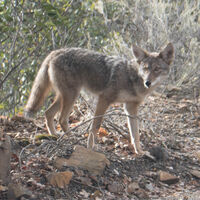canids
family Canidae
Member of
carnivorans (order Carnivora)
placental mammals (infraclass Placentalia)
mammals (class Mammalia)
animals (kingdom Animalia)
There are no other wild members of this family in the bay area.
Canines are generally easily distinguished by sight. Tracks are harder, especially when domesticated dogs are considered.
Canines have one front lobe and two rear lobes in their heel pads, whereas cats have two front lobes and three rear lobes in each heel pad. [source] Some canines are more or less likely to leave claw impressions depending on conditions; cats never leave claw impressions. Tracks made by canine hind feet are smaller than those left by front feet.
Canis latrans
- about 20–50 pounds
- tracks are 2¼–2¾ inches long by 1¾–2½ inches wide.
- toes are typically compact and near parallel. (A domestic dog’s toes are often more spread and splayed.)
- tracks tend to be in a straight line. (A domestic dog often wanders unless heeled to a human, who would also leave tracks.)
- coyotes use various gaits; a typical trot leaves the rear track slightly behind the front track, sometimes with a slightly overlap
- More ID info is here.
gray fox
Urocyon cinereoargenteus
- about 7–14 pounds
- coat is mostly gray, but may have a reddish head chest, and legs
- tracks have a larger gap between pads and are less distinct than coyote due to fur between toe pads
- front and rear tracks often overlap significantly [source]
- the red fox and kit fox are rarer in the bay area
1 observed taxon / 3 unobserved taxons / 2 keys
Locations: Months: For more details, use advanced search.
Chris’s observations: 17 (14 are research grade)
Taxon info: iNaturalist
Bay Area species: iNaturalist
